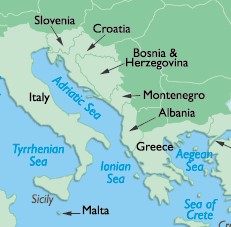A long time ago, I had to study an essay called ‘Eupalinos ou l’architecte’ by Paul Valery. At the time, it made very little sense to an eighteen-year old from Bradford, but somehow part of it has stuck. There was in it, I think, quite a bit about the scope for creativity generated where sea meets shore, and unexpected things get thrown up completely at random. The idea that new ideas are most easily found in situations I now know to call ‘liminal’ seems to work quite well for all kinds of things and I can now link it with colour theory – green can be made to look very different if you put it against red or against yellow – as well as with literature and history.
I think now that there is a kind of seashore moment between history, particularly cultural history, and anthropology. Historians tend to think in terms of time and events, anthropologists in terms of geography and the everyday, so if you introduce an anthropological element to a historical situation, or vice versa you get to see a culture taken out of its historical or geographical context and that could spark something new. Naturally, there are risks. These are helpfully analysed by Conrad Leyser, who sees the greatest risk as being that of circular reasoning: anthropologists tend to see primitive societies through the prism of the history they learned at school, historians then recognise the picture drawn by anthropologists as relating to a historical period and round and round you go.[1] But it’s worth a shot.
In the short term, I’m wrestling with a modern article on identity in its anthropological sense, which seems to relate directly to us now. It is written by a Serb, Zagora Golubovic, and starts off with a survey of various academic studies of identity, looking particularly at the possibility of having more than one kind of identity.[2] Everyone starts off with a sense of belonging to a primary group, usually the family, which he calls a ‘personal identity’. Later, the individual acquires a ‘collective identity’: an individual retains her personal identity, but then adds a secondary socialization group – a school, factory etc. which brings with it the need to conform, to learn how to behave as a member of the group. For some individuals, at this point, ‘free determination’ becomes possible and an individual may separate from the group and see herself as unique. Golubovic believes that this third type of identity is only open to a few as it involves severing the ‘umbilical cord’ that connects to the group.
Golubovic moves quite swiftly to a modern example and looks back at the former Yugoslavia as an example of a state which, although it encompassed many different ethnic identities which were presumably related to the primary group and thus seen as ‘personal’, did, in his view, have a acquired ‘collective’ identity which was fostered by a proactive state.
Now it h as broken up into several different states, based on ethnicity, and that collective identity has been lost. Gulabovic’s proposal is that the role of the EU should be to consciously establish a corporate identity, a cultural paradigm which might embrace the entire European community, particularly those areas that feel excluded from the current EU because of its overuse of English.
as broken up into several different states, based on ethnicity, and that collective identity has been lost. Gulabovic’s proposal is that the role of the EU should be to consciously establish a corporate identity, a cultural paradigm which might embrace the entire European community, particularly those areas that feel excluded from the current EU because of its overuse of English.
I hold no brief for defending this thesis. It is way outside my field and the article turned up in a Google search for anthropological discussions of identity and really drew my attention because of the current EU debate. But you could take this taxonomy and apply it to my dead monks.
So, in the medium term, I want to get my head round how this might apply to ninth century monks who probably never gave identity a thought. However, they did have a sense of belonging to something and a sense of mission. Collectively, they were tasked with ensuring the ‘correctness’ Charlemagne wanted to achieve in religious observance and it has been often argued that unity of religion was one of the ways through which Charlemagne sought to hold his large and disparate kingdom together. Some individuals were tasked with elucidating the faith and dealing with heresy in its various forms. All this was part of creating, refining and enforcing a thread that gave a common identity to Charlemagne’s people. But they were also men of God, answering to a higher authority and tasked with holding even rulers to account. And they were sons of a monastery, responsible for teaching and learning and worshipping in a fixed place which had some sense of identity, often via foundation myths. So how should we analyse their identity?
I think this is worth pursuing. Watch this space. It may be a place where the sea meets the shore.
[1] ‘Making Early Medieval Societies: Conflict and Belonging in the Latin West 300-1200’ ed. K Cooper and C Leyser CUP 2016
[2] ‘An anthropological conceptualization of Identity’ Zagorka Golubovic in Synthesis Philosophia 51 (1/2011) pp 24 – 43


